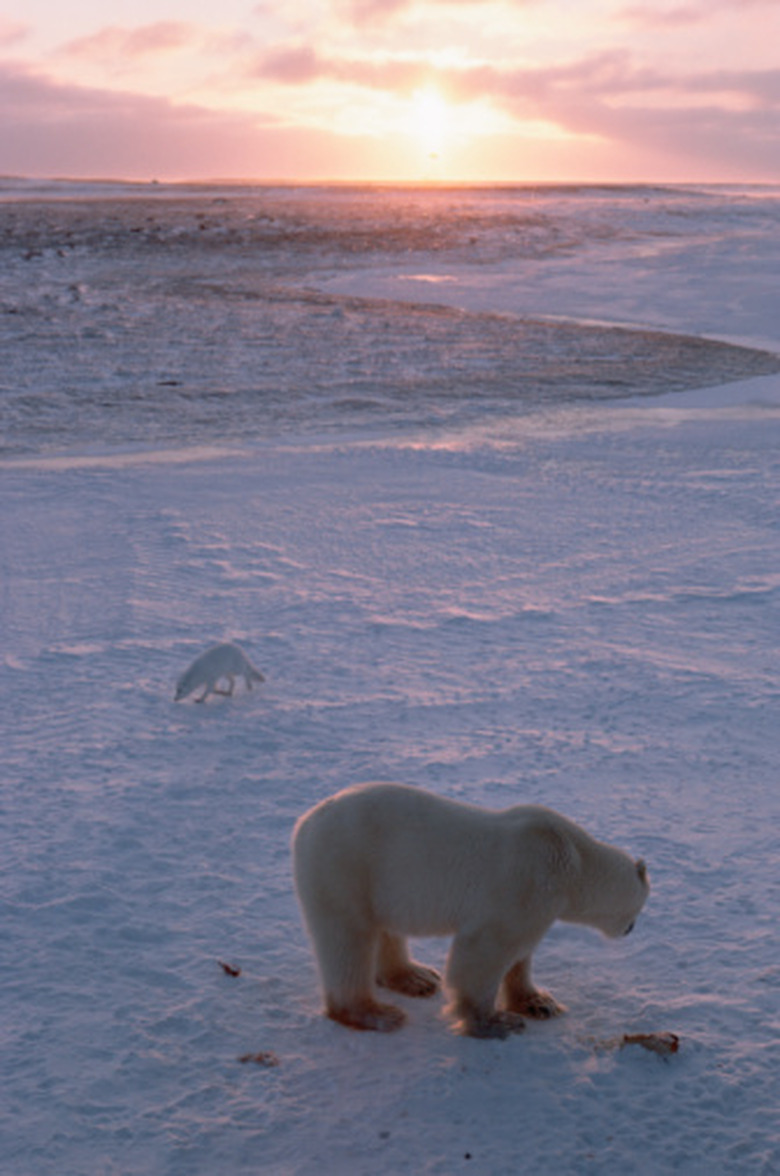Tundra Biomes & Abiotic Factors
Multiple ecosystems and hundreds of plant and animal species exist in the tundra biome. It encompasses both arctic and alpine tundra. The arctic tundra resembles a snowy desert surrounding the North Pole, while the alpine tundra is located in the cold high altitudes of tall mountain ranges. The species that live in these regions are limited to those that can survive, given the harsh abiotic, or non-living, factors involved.
Temperature
Temperature
Temperature is a significant abiotic factor in the tundra region, and it severely limits the types of species that can live there. Temperatures during the arctic winter drop to averages of minus 30 degrees Fahrenheit and only reach an average of plus 50 degrees in the summer. The warmer temperatures in the summer months are the only reason that any life can survive in the arctic. The alpine tundra is also cold, but not nearly as cold as the arctic. Temperatures at night are almost always below freezing, but daytime temperatures still permit plant growth for about half the year. However, the high altitude limits the species of plants that can grow in this region, and the species that live here are similar to those living in the arctic.
Wind and Water
Wind and Water
Both alpine and arctic tundra are extremely windy biomes and have small amounts of rainfall. The high winds make it difficult for any large plant species to survive, and only shrubby, small vegetation inhabits these regions. The average rainfall in the arctic tundra is only six to 10 inches, and this includes the melting snow in the summer months. Despite the low rainfall, the arctic has high humidity, because water is slow to evaporate. The average rainfall varies in the alpine regions. It's limited by altitude and wind; the windier sides of mountains have higher rainfall. The precipitation level in both regions is similar enough to classify them as part of the same biome.
Soil
Soil
Another abiotic factor in both the alpine and arctic tundra is permafrost, a layer of subsoil that has been frozen for least two years. The depth of the permafrost varies throughout the seasons and regions, but it is ever-present in almost all areas of the tundra. If the permafrost melts, it alters the temperature and topography of a region, which threatens the existence of many species living in the tundra. On top of the permafrost is an active layer of soil that thaws in the summer months. The thawing of this small layer allows vegetation to grow and enables the chemical processes necessary for sustaining life to occur.
Nutrients
Nutrients
The amounts and types of nutrients present in the air and soil represent another abiotic factor. Phosphorous and nitrogen are the major nutrients that exist in the tundra biome. Precipitation produces phosphorous, while a bio-chemical process creates nitrogen. Through photosynthesis, plants harvest energy from the sun, which they use to absorb these key nutrients and grow. The nutrients are cycled through the ecosystem as animals eat the plants. When the animals eventually die and decompose, the nutrients return to the soil. This is one example of how abiotic factors, such as the chemical nutrients present in a biome, affect biotic factors.
References
- The Encyclopedia of Earth; Tundra Biome; University of California Museum of Paleonto; Dec. 2009
- The Encyclopedia of Earth; Abiotic Factor; C Michael Hogan PhD.; July 2010
- The Encyclopedia of Earth; AP Environmental Science Chapter 5- The Biosphere; May 2010
- The Encyclopedia of Earth; Introduction to Arctic Tundra and Polar Desert Ecosystems; International Arctic Science Committee; Feb 2010
- The Encyclopedia of Earth; Permafrost in the Arctic; International Arctic Science Committee; Feb 2010
Cite This Article
MLA
Kang, Starr. "Tundra Biomes & Abiotic Factors" sciencing.com, https://www.sciencing.com/tundra-biomes-abiotic-factors-8260321/. 22 November 2019.
APA
Kang, Starr. (2019, November 22). Tundra Biomes & Abiotic Factors. sciencing.com. Retrieved from https://www.sciencing.com/tundra-biomes-abiotic-factors-8260321/
Chicago
Kang, Starr. Tundra Biomes & Abiotic Factors last modified March 24, 2022. https://www.sciencing.com/tundra-biomes-abiotic-factors-8260321/
